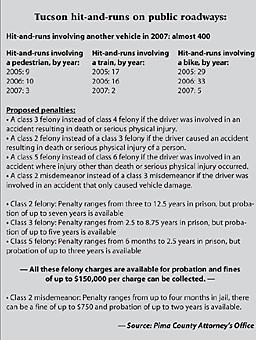PHOENIX – Hit-and-run drivers will have to put up with stiffer penalties in the future if legislators pass a bill that is intended to stop drivers from leaving the scene of an accident.
Senate Bill 1118 would move up penalties for all hit-and-run accidents, whether or not they result in death or serious injury of the victim.
Penalties would also increase if the driver leaving the scene was at fault for the crash and if the accident only caused damage to another vehicle.
Three pedestrians have been involved in a hit-and-run on Tucson public roadways in 2007, compared to five bicycle riders, two trains and almost 400 other vehicles, according to the Tucson Police Department Web site.
Drivers know that penalties for drinking and driving are tough and penalties for getting into an accident are tough. However, lawmakers need to ensure that the penalties for leaving the scene are even tougher, said Sen. Jim Waring, R-Phoenix, who first introduced the measure in the Arizona state Legislature.
“”People need to be disincentivized from leaving the scene of an accident or try to take off,”” he said.
Sometimes, people leave the scene of an accident when they are drunk in the hopes of getting rid of alcohol in their system until the police catch them, said Rep. Andy Biggs, R-Gilbert, in a House Transportation Committee hearing on March 22.
Other reasons drivers tend to leave the accident scene could be that they don’t have insurance, that their driver’s license is suspended or that they have a warrant, said TPD spokesman Sgt. Decio Hopffer.
“”It could be a variety of things that could prompt them to not stay at the scene,”” Hopffer said. “”But by law you are obliged to it. You’re only compounding your problems by leaving the scene.””
Some people think they can get away with it, Hopffer said, but there are several measures police can take to track down the driver, such as running the license plate, searching for a particular car and following up on a description of the person.
That’s why it is important victims try to memorize those things, even if they are in shock after the incident, Hopffer said.
“”A lot of times, things happen, you kind of panic, and by the time you regain your senses you look and the car is gone,”” he said. “”Then there is not much for us to go on, and those cases are closed.””
While it is important to memorize certain information about cars and drivers, Hopffer said victims or bystanders should not follow the car and try to pursue it themselves.
Hopffer said he doesn’t know how many cases remain unsolved.









